NRSG353 Case Study: Understanding Liver Cirrhosis - A Patient Approach
VerifiedAdded on 2023/06/15
|9
|2863
|52
Case Study
AI Summary
This assignment provides a comprehensive analysis of liver cirrhosis, addressing its risk factors, incidence, and impact on patients and their families. It identifies common signs and symptoms, linking them to their underlying pathophysiology. The assignment also describes two standard classes of drugs used in treating liver cirrhosis, detailing their physiological effects on the body. Furthermore, it outlines essential nursing care strategies to be implemented within the first 24 hours of a patient's admission, emphasizing a prioritized approach to assessment, diagnosis, healthcare planning, prescription, evaluation, and prognosis. Desklib offers a wealth of similar case studies and resources for students.
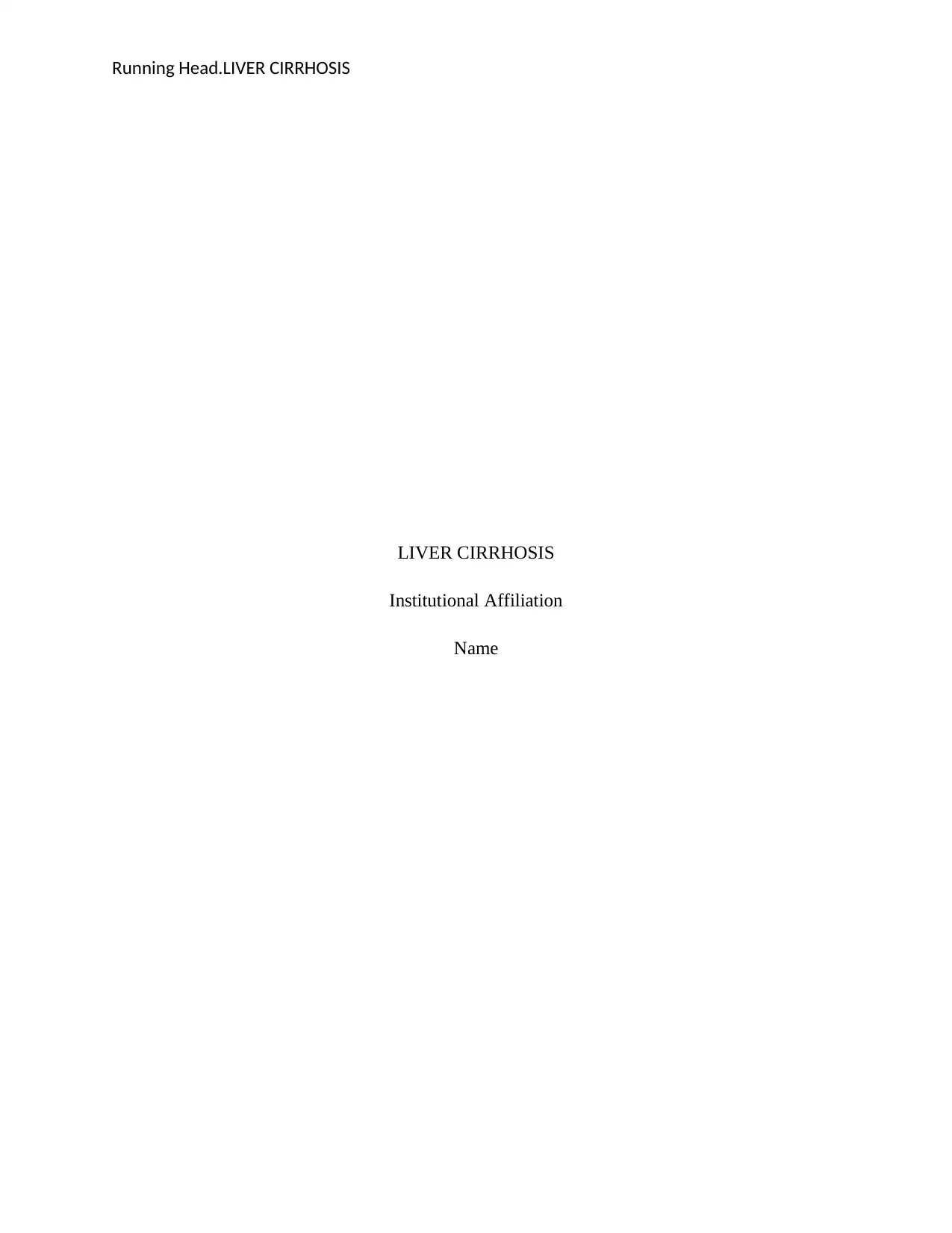
Running Head.LIVER CIRRHOSIS
LIVER CIRRHOSIS
Institutional Affiliation
Name
LIVER CIRRHOSIS
Institutional Affiliation
Name
Paraphrase This Document
Need a fresh take? Get an instant paraphrase of this document with our AI Paraphraser
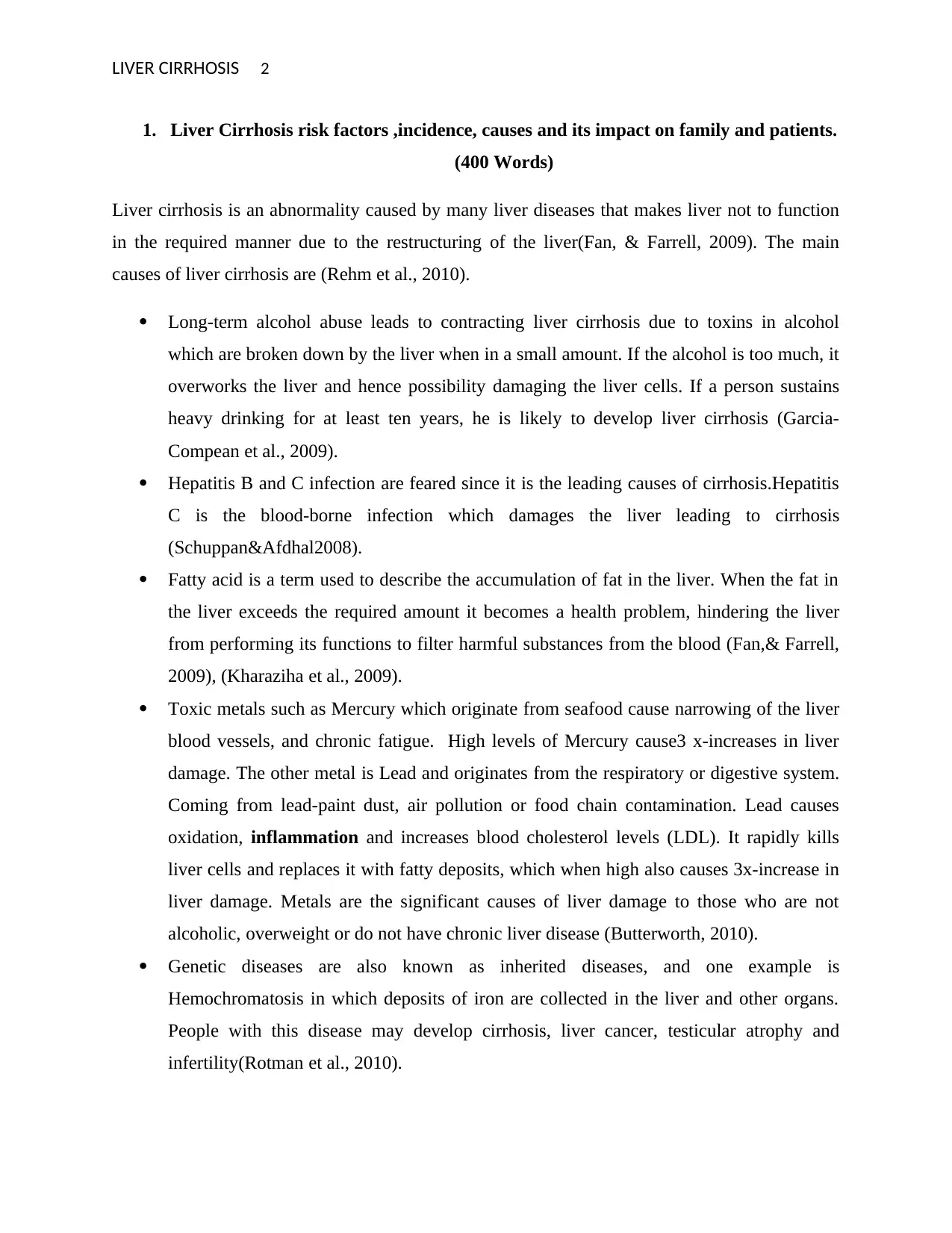
LIVER CIRRHOSIS 2
1. Liver Cirrhosis risk factors ,incidence, causes and its impact on family and patients.
(400 Words)
Liver cirrhosis is an abnormality caused by many liver diseases that makes liver not to function
in the required manner due to the restructuring of the liver(Fan, & Farrell, 2009). The main
causes of liver cirrhosis are (Rehm et al., 2010).
Long-term alcohol abuse leads to contracting liver cirrhosis due to toxins in alcohol
which are broken down by the liver when in a small amount. If the alcohol is too much, it
overworks the liver and hence possibility damaging the liver cells. If a person sustains
heavy drinking for at least ten years, he is likely to develop liver cirrhosis (Garcia-
Compean et al., 2009).
Hepatitis B and C infection are feared since it is the leading causes of cirrhosis.Hepatitis
C is the blood-borne infection which damages the liver leading to cirrhosis
(Schuppan&Afdhal2008).
Fatty acid is a term used to describe the accumulation of fat in the liver. When the fat in
the liver exceeds the required amount it becomes a health problem, hindering the liver
from performing its functions to filter harmful substances from the blood (Fan,& Farrell,
2009), (Kharaziha et al., 2009).
Toxic metals such as Mercury which originate from seafood cause narrowing of the liver
blood vessels, and chronic fatigue. High levels of Mercury cause3 x-increases in liver
damage. The other metal is Lead and originates from the respiratory or digestive system.
Coming from lead-paint dust, air pollution or food chain contamination. Lead causes
oxidation, inflammation and increases blood cholesterol levels (LDL). It rapidly kills
liver cells and replaces it with fatty deposits, which when high also causes 3x-increase in
liver damage. Metals are the significant causes of liver damage to those who are not
alcoholic, overweight or do not have chronic liver disease (Butterworth, 2010).
Genetic diseases are also known as inherited diseases, and one example is
Hemochromatosis in which deposits of iron are collected in the liver and other organs.
People with this disease may develop cirrhosis, liver cancer, testicular atrophy and
infertility(Rotman et al., 2010).
1. Liver Cirrhosis risk factors ,incidence, causes and its impact on family and patients.
(400 Words)
Liver cirrhosis is an abnormality caused by many liver diseases that makes liver not to function
in the required manner due to the restructuring of the liver(Fan, & Farrell, 2009). The main
causes of liver cirrhosis are (Rehm et al., 2010).
Long-term alcohol abuse leads to contracting liver cirrhosis due to toxins in alcohol
which are broken down by the liver when in a small amount. If the alcohol is too much, it
overworks the liver and hence possibility damaging the liver cells. If a person sustains
heavy drinking for at least ten years, he is likely to develop liver cirrhosis (Garcia-
Compean et al., 2009).
Hepatitis B and C infection are feared since it is the leading causes of cirrhosis.Hepatitis
C is the blood-borne infection which damages the liver leading to cirrhosis
(Schuppan&Afdhal2008).
Fatty acid is a term used to describe the accumulation of fat in the liver. When the fat in
the liver exceeds the required amount it becomes a health problem, hindering the liver
from performing its functions to filter harmful substances from the blood (Fan,& Farrell,
2009), (Kharaziha et al., 2009).
Toxic metals such as Mercury which originate from seafood cause narrowing of the liver
blood vessels, and chronic fatigue. High levels of Mercury cause3 x-increases in liver
damage. The other metal is Lead and originates from the respiratory or digestive system.
Coming from lead-paint dust, air pollution or food chain contamination. Lead causes
oxidation, inflammation and increases blood cholesterol levels (LDL). It rapidly kills
liver cells and replaces it with fatty deposits, which when high also causes 3x-increase in
liver damage. Metals are the significant causes of liver damage to those who are not
alcoholic, overweight or do not have chronic liver disease (Butterworth, 2010).
Genetic diseases are also known as inherited diseases, and one example is
Hemochromatosis in which deposits of iron are collected in the liver and other organs.
People with this disease may develop cirrhosis, liver cancer, testicular atrophy and
infertility(Rotman et al., 2010).
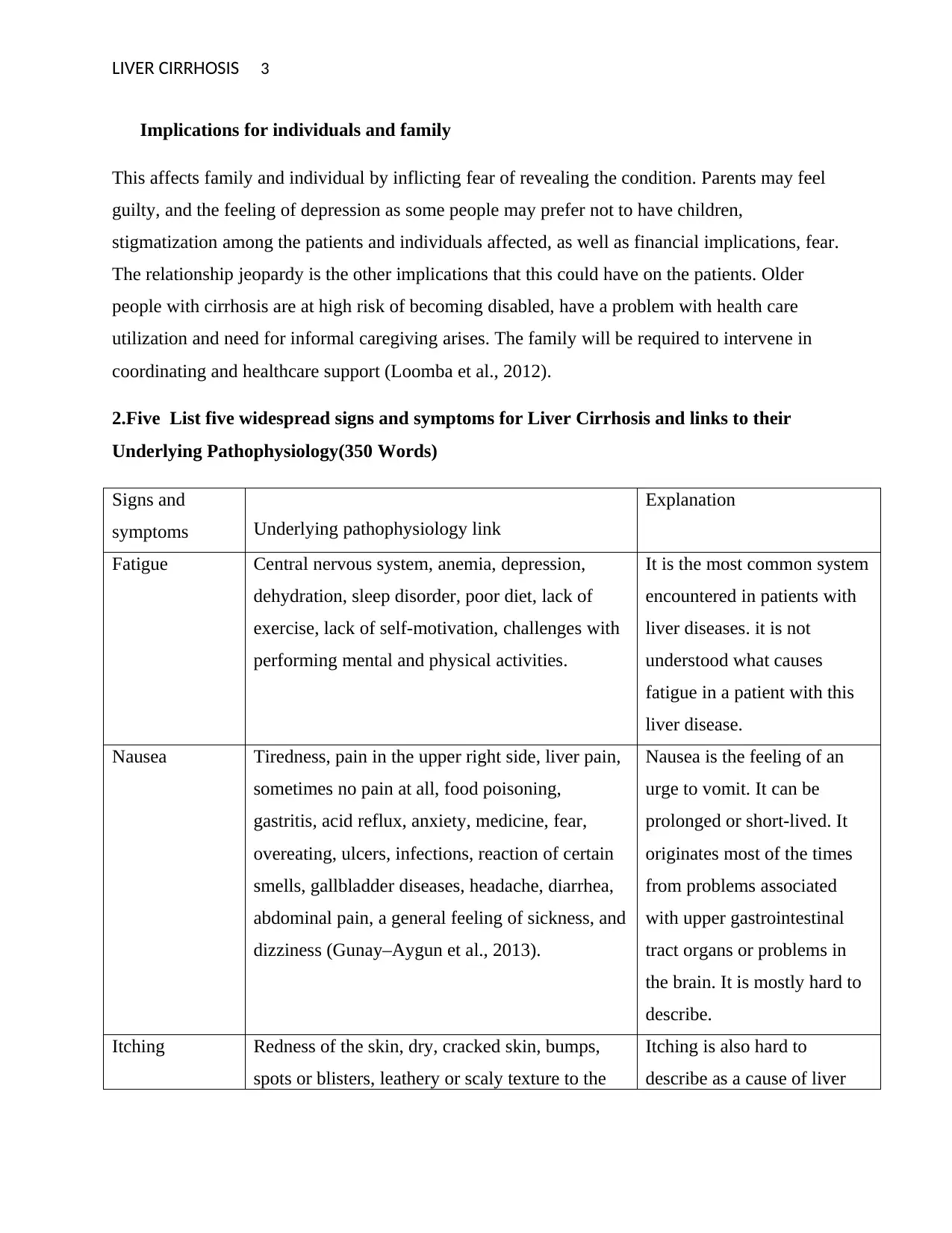
LIVER CIRRHOSIS 3
Implications for individuals and family
This affects family and individual by inflicting fear of revealing the condition. Parents may feel
guilty, and the feeling of depression as some people may prefer not to have children,
stigmatization among the patients and individuals affected, as well as financial implications, fear.
The relationship jeopardy is the other implications that this could have on the patients. Older
people with cirrhosis are at high risk of becoming disabled, have a problem with health care
utilization and need for informal caregiving arises. The family will be required to intervene in
coordinating and healthcare support (Loomba et al., 2012).
2.Five List five widespread signs and symptoms for Liver Cirrhosis and links to their
Underlying Pathophysiology(350 Words)
Signs and
symptoms Underlying pathophysiology link
Explanation
Fatigue Central nervous system, anemia, depression,
dehydration, sleep disorder, poor diet, lack of
exercise, lack of self-motivation, challenges with
performing mental and physical activities.
It is the most common system
encountered in patients with
liver diseases. it is not
understood what causes
fatigue in a patient with this
liver disease.
Nausea Tiredness, pain in the upper right side, liver pain,
sometimes no pain at all, food poisoning,
gastritis, acid reflux, anxiety, medicine, fear,
overeating, ulcers, infections, reaction of certain
smells, gallbladder diseases, headache, diarrhea,
abdominal pain, a general feeling of sickness, and
dizziness (Gunay–Aygun et al., 2013).
Nausea is the feeling of an
urge to vomit. It can be
prolonged or short-lived. It
originates most of the times
from problems associated
with upper gastrointestinal
tract organs or problems in
the brain. It is mostly hard to
describe.
Itching Redness of the skin, dry, cracked skin, bumps,
spots or blisters, leathery or scaly texture to the
Itching is also hard to
describe as a cause of liver
Implications for individuals and family
This affects family and individual by inflicting fear of revealing the condition. Parents may feel
guilty, and the feeling of depression as some people may prefer not to have children,
stigmatization among the patients and individuals affected, as well as financial implications, fear.
The relationship jeopardy is the other implications that this could have on the patients. Older
people with cirrhosis are at high risk of becoming disabled, have a problem with health care
utilization and need for informal caregiving arises. The family will be required to intervene in
coordinating and healthcare support (Loomba et al., 2012).
2.Five List five widespread signs and symptoms for Liver Cirrhosis and links to their
Underlying Pathophysiology(350 Words)
Signs and
symptoms Underlying pathophysiology link
Explanation
Fatigue Central nervous system, anemia, depression,
dehydration, sleep disorder, poor diet, lack of
exercise, lack of self-motivation, challenges with
performing mental and physical activities.
It is the most common system
encountered in patients with
liver diseases. it is not
understood what causes
fatigue in a patient with this
liver disease.
Nausea Tiredness, pain in the upper right side, liver pain,
sometimes no pain at all, food poisoning,
gastritis, acid reflux, anxiety, medicine, fear,
overeating, ulcers, infections, reaction of certain
smells, gallbladder diseases, headache, diarrhea,
abdominal pain, a general feeling of sickness, and
dizziness (Gunay–Aygun et al., 2013).
Nausea is the feeling of an
urge to vomit. It can be
prolonged or short-lived. It
originates most of the times
from problems associated
with upper gastrointestinal
tract organs or problems in
the brain. It is mostly hard to
describe.
Itching Redness of the skin, dry, cracked skin, bumps,
spots or blisters, leathery or scaly texture to the
Itching is also hard to
describe as a cause of liver
⊘ This is a preview!⊘
Do you want full access?
Subscribe today to unlock all pages.

Trusted by 1+ million students worldwide
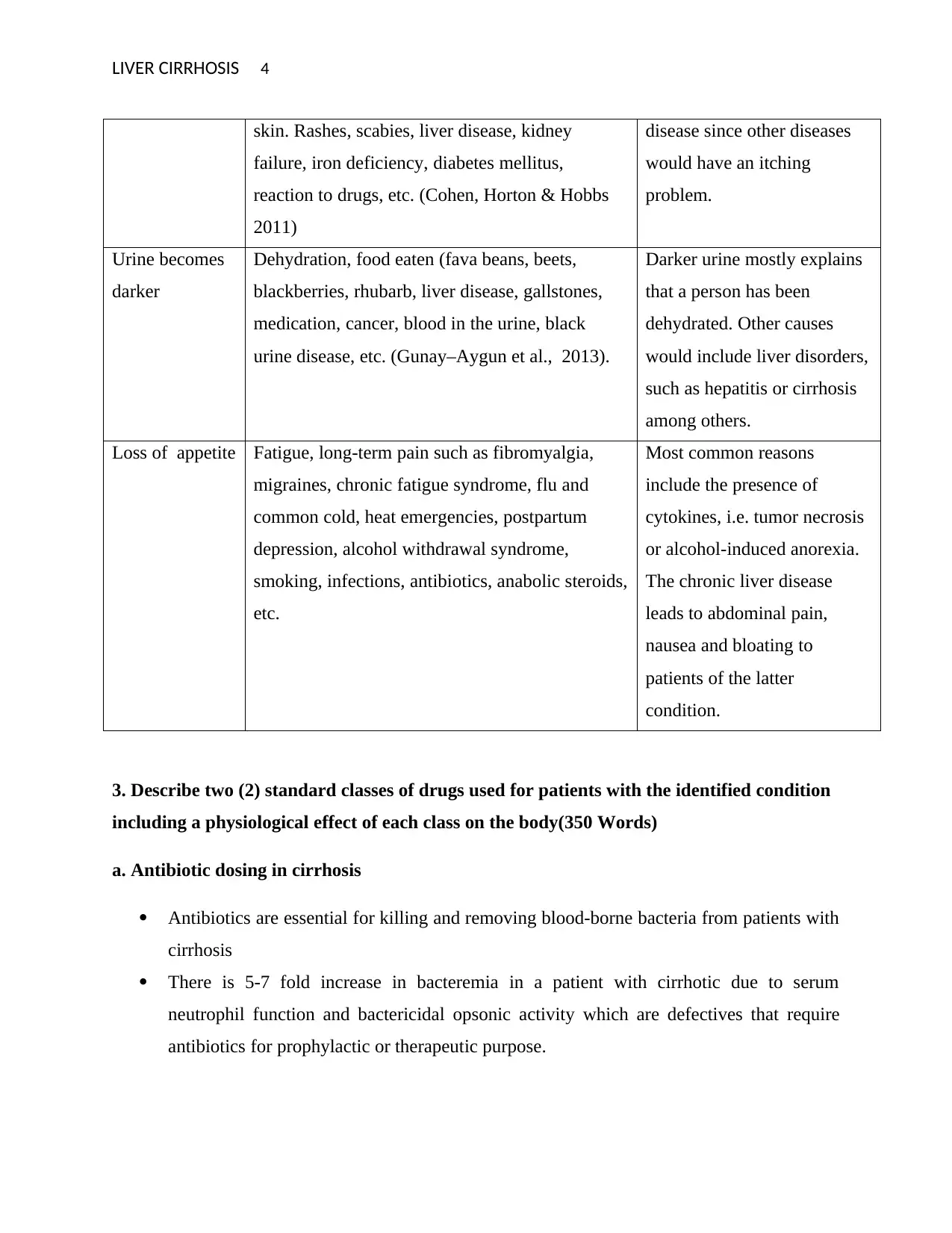
LIVER CIRRHOSIS 4
skin. Rashes, scabies, liver disease, kidney
failure, iron deficiency, diabetes mellitus,
reaction to drugs, etc. (Cohen, Horton & Hobbs
2011)
disease since other diseases
would have an itching
problem.
Urine becomes
darker
Dehydration, food eaten (fava beans, beets,
blackberries, rhubarb, liver disease, gallstones,
medication, cancer, blood in the urine, black
urine disease, etc. (Gunay–Aygun et al., 2013).
Darker urine mostly explains
that a person has been
dehydrated. Other causes
would include liver disorders,
such as hepatitis or cirrhosis
among others.
Loss of appetite Fatigue, long-term pain such as fibromyalgia,
migraines, chronic fatigue syndrome, flu and
common cold, heat emergencies, postpartum
depression, alcohol withdrawal syndrome,
smoking, infections, antibiotics, anabolic steroids,
etc.
Most common reasons
include the presence of
cytokines, i.e. tumor necrosis
or alcohol-induced anorexia.
The chronic liver disease
leads to abdominal pain,
nausea and bloating to
patients of the latter
condition.
3. Describe two (2) standard classes of drugs used for patients with the identified condition
including a physiological effect of each class on the body(350 Words)
a. Antibiotic dosing in cirrhosis
Antibiotics are essential for killing and removing blood-borne bacteria from patients with
cirrhosis
There is 5-7 fold increase in bacteremia in a patient with cirrhotic due to serum
neutrophil function and bactericidal opsonic activity which are defectives that require
antibiotics for prophylactic or therapeutic purpose.
skin. Rashes, scabies, liver disease, kidney
failure, iron deficiency, diabetes mellitus,
reaction to drugs, etc. (Cohen, Horton & Hobbs
2011)
disease since other diseases
would have an itching
problem.
Urine becomes
darker
Dehydration, food eaten (fava beans, beets,
blackberries, rhubarb, liver disease, gallstones,
medication, cancer, blood in the urine, black
urine disease, etc. (Gunay–Aygun et al., 2013).
Darker urine mostly explains
that a person has been
dehydrated. Other causes
would include liver disorders,
such as hepatitis or cirrhosis
among others.
Loss of appetite Fatigue, long-term pain such as fibromyalgia,
migraines, chronic fatigue syndrome, flu and
common cold, heat emergencies, postpartum
depression, alcohol withdrawal syndrome,
smoking, infections, antibiotics, anabolic steroids,
etc.
Most common reasons
include the presence of
cytokines, i.e. tumor necrosis
or alcohol-induced anorexia.
The chronic liver disease
leads to abdominal pain,
nausea and bloating to
patients of the latter
condition.
3. Describe two (2) standard classes of drugs used for patients with the identified condition
including a physiological effect of each class on the body(350 Words)
a. Antibiotic dosing in cirrhosis
Antibiotics are essential for killing and removing blood-borne bacteria from patients with
cirrhosis
There is 5-7 fold increase in bacteremia in a patient with cirrhotic due to serum
neutrophil function and bactericidal opsonic activity which are defectives that require
antibiotics for prophylactic or therapeutic purpose.
Paraphrase This Document
Need a fresh take? Get an instant paraphrase of this document with our AI Paraphraser
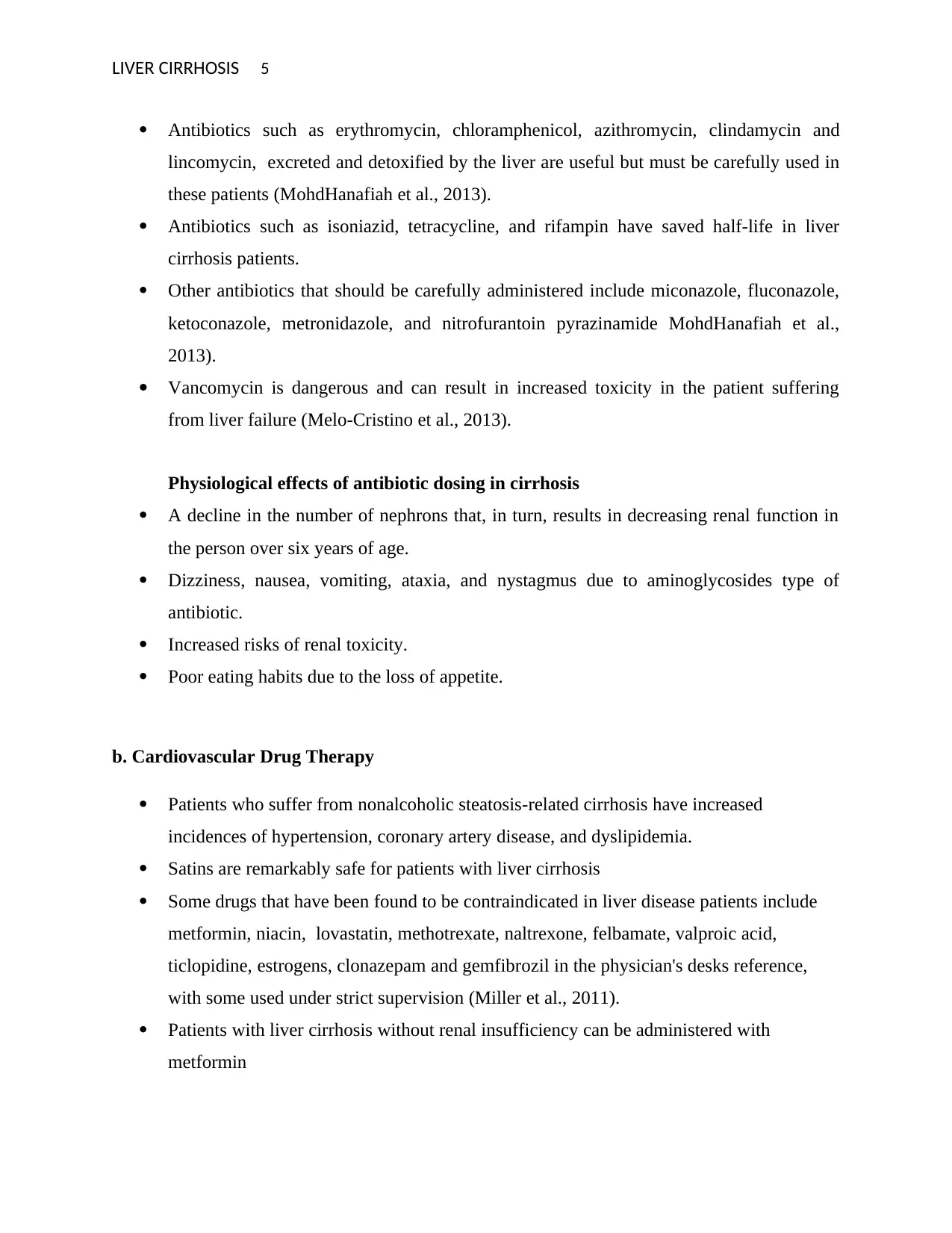
LIVER CIRRHOSIS 5
Antibiotics such as erythromycin, chloramphenicol, azithromycin, clindamycin and
lincomycin, excreted and detoxified by the liver are useful but must be carefully used in
these patients (MohdHanafiah et al., 2013).
Antibiotics such as isoniazid, tetracycline, and rifampin have saved half-life in liver
cirrhosis patients.
Other antibiotics that should be carefully administered include miconazole, fluconazole,
ketoconazole, metronidazole, and nitrofurantoin pyrazinamide MohdHanafiah et al.,
2013).
Vancomycin is dangerous and can result in increased toxicity in the patient suffering
from liver failure (Melo-Cristino et al., 2013).
Physiological effects of antibiotic dosing in cirrhosis
A decline in the number of nephrons that, in turn, results in decreasing renal function in
the person over six years of age.
Dizziness, nausea, vomiting, ataxia, and nystagmus due to aminoglycosides type of
antibiotic.
Increased risks of renal toxicity.
Poor eating habits due to the loss of appetite.
b. Cardiovascular Drug Therapy
Patients who suffer from nonalcoholic steatosis-related cirrhosis have increased
incidences of hypertension, coronary artery disease, and dyslipidemia.
Satins are remarkably safe for patients with liver cirrhosis
Some drugs that have been found to be contraindicated in liver disease patients include
metformin, niacin, lovastatin, methotrexate, naltrexone, felbamate, valproic acid,
ticlopidine, estrogens, clonazepam and gemfibrozil in the physician's desks reference,
with some used under strict supervision (Miller et al., 2011).
Patients with liver cirrhosis without renal insufficiency can be administered with
metformin
Antibiotics such as erythromycin, chloramphenicol, azithromycin, clindamycin and
lincomycin, excreted and detoxified by the liver are useful but must be carefully used in
these patients (MohdHanafiah et al., 2013).
Antibiotics such as isoniazid, tetracycline, and rifampin have saved half-life in liver
cirrhosis patients.
Other antibiotics that should be carefully administered include miconazole, fluconazole,
ketoconazole, metronidazole, and nitrofurantoin pyrazinamide MohdHanafiah et al.,
2013).
Vancomycin is dangerous and can result in increased toxicity in the patient suffering
from liver failure (Melo-Cristino et al., 2013).
Physiological effects of antibiotic dosing in cirrhosis
A decline in the number of nephrons that, in turn, results in decreasing renal function in
the person over six years of age.
Dizziness, nausea, vomiting, ataxia, and nystagmus due to aminoglycosides type of
antibiotic.
Increased risks of renal toxicity.
Poor eating habits due to the loss of appetite.
b. Cardiovascular Drug Therapy
Patients who suffer from nonalcoholic steatosis-related cirrhosis have increased
incidences of hypertension, coronary artery disease, and dyslipidemia.
Satins are remarkably safe for patients with liver cirrhosis
Some drugs that have been found to be contraindicated in liver disease patients include
metformin, niacin, lovastatin, methotrexate, naltrexone, felbamate, valproic acid,
ticlopidine, estrogens, clonazepam and gemfibrozil in the physician's desks reference,
with some used under strict supervision (Miller et al., 2011).
Patients with liver cirrhosis without renal insufficiency can be administered with
metformin

LIVER CIRRHOSIS 6
Alternative drugs for such patients would include second-generation sulfonylureas such
as Glimepiride and glipizide.
Some drugs in this class should be used with strict supervision and monitoring such as
Thiazolidinediones since it can cause drug hepatitis.
Drugs in this class are to be administered individually depending on various factors since
prescribing medications to patients with liver cirrhosis is challenging since one cannot
determine whether they have been altered (Valenti et al., 2010).
Physiological effects
Darkening of the lungs
Narrowing of blood capillaries
Breathlessness due to blockage in the capillaries/difficulty breathing
Increase heartbeat
Loss of body weight
Loss of appetite
4. Nursing care strategies I should use for the patient within 24 hrs after their admission,
explained in the order of priority (500 Words)
According to Horta (1979), nursing process is the dynamics of systemized and interrelated
actions, of helping a human being.As a nurse, it is my responsibility to ensure that educational,
psychological and physical needs of patients are met.Aspects such as educating the patients
improves their ability to deal with symptoms and other serious treatment complications.The
following are the steps that I should use in order of their priority, after the admission of the
patient.
a. Assessment. This is obtaining data through systematic roadmap, by making it easy to
determine the actual problems, the potential of individual family and society. There is a
need to do a thorough assessment before any action is taken to determine the medical
history of the patient to be able to diagnose the patient accurately.
b. Nursing diagnosis. It is the identification of the basic needs of the patient as well as the
determination of the degree of care needed by the individual patient. This is vital because
Alternative drugs for such patients would include second-generation sulfonylureas such
as Glimepiride and glipizide.
Some drugs in this class should be used with strict supervision and monitoring such as
Thiazolidinediones since it can cause drug hepatitis.
Drugs in this class are to be administered individually depending on various factors since
prescribing medications to patients with liver cirrhosis is challenging since one cannot
determine whether they have been altered (Valenti et al., 2010).
Physiological effects
Darkening of the lungs
Narrowing of blood capillaries
Breathlessness due to blockage in the capillaries/difficulty breathing
Increase heartbeat
Loss of body weight
Loss of appetite
4. Nursing care strategies I should use for the patient within 24 hrs after their admission,
explained in the order of priority (500 Words)
According to Horta (1979), nursing process is the dynamics of systemized and interrelated
actions, of helping a human being.As a nurse, it is my responsibility to ensure that educational,
psychological and physical needs of patients are met.Aspects such as educating the patients
improves their ability to deal with symptoms and other serious treatment complications.The
following are the steps that I should use in order of their priority, after the admission of the
patient.
a. Assessment. This is obtaining data through systematic roadmap, by making it easy to
determine the actual problems, the potential of individual family and society. There is a
need to do a thorough assessment before any action is taken to determine the medical
history of the patient to be able to diagnose the patient accurately.
b. Nursing diagnosis. It is the identification of the basic needs of the patient as well as the
determination of the degree of care needed by the individual patient. This is vital because
⊘ This is a preview!⊘
Do you want full access?
Subscribe today to unlock all pages.

Trusted by 1+ million students worldwide
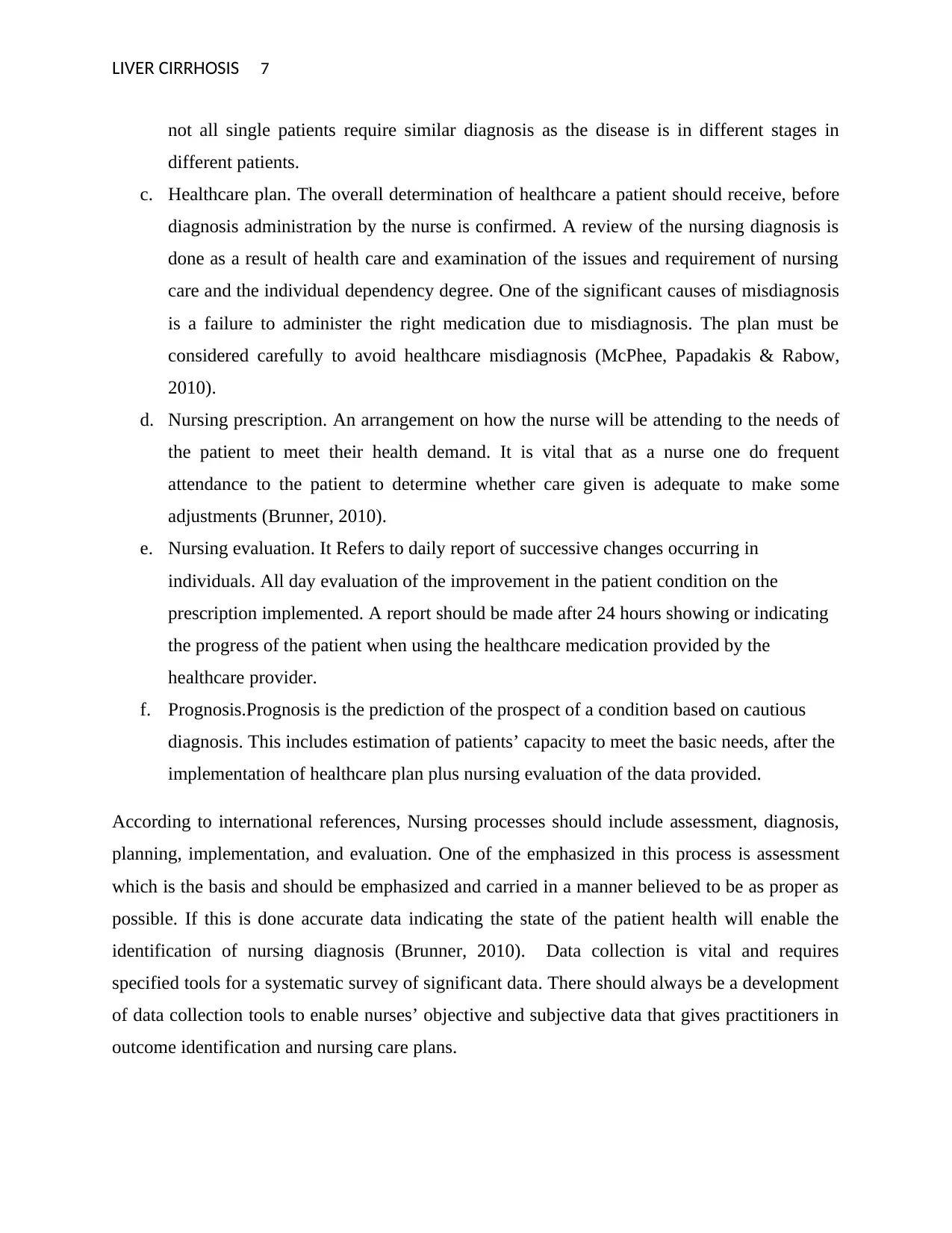
LIVER CIRRHOSIS 7
not all single patients require similar diagnosis as the disease is in different stages in
different patients.
c. Healthcare plan. The overall determination of healthcare a patient should receive, before
diagnosis administration by the nurse is confirmed. A review of the nursing diagnosis is
done as a result of health care and examination of the issues and requirement of nursing
care and the individual dependency degree. One of the significant causes of misdiagnosis
is a failure to administer the right medication due to misdiagnosis. The plan must be
considered carefully to avoid healthcare misdiagnosis (McPhee, Papadakis & Rabow,
2010).
d. Nursing prescription. An arrangement on how the nurse will be attending to the needs of
the patient to meet their health demand. It is vital that as a nurse one do frequent
attendance to the patient to determine whether care given is adequate to make some
adjustments (Brunner, 2010).
e. Nursing evaluation. It Refers to daily report of successive changes occurring in
individuals. All day evaluation of the improvement in the patient condition on the
prescription implemented. A report should be made after 24 hours showing or indicating
the progress of the patient when using the healthcare medication provided by the
healthcare provider.
f. Prognosis.Prognosis is the prediction of the prospect of a condition based on cautious
diagnosis. This includes estimation of patients’ capacity to meet the basic needs, after the
implementation of healthcare plan plus nursing evaluation of the data provided.
According to international references, Nursing processes should include assessment, diagnosis,
planning, implementation, and evaluation. One of the emphasized in this process is assessment
which is the basis and should be emphasized and carried in a manner believed to be as proper as
possible. If this is done accurate data indicating the state of the patient health will enable the
identification of nursing diagnosis (Brunner, 2010). Data collection is vital and requires
specified tools for a systematic survey of significant data. There should always be a development
of data collection tools to enable nurses’ objective and subjective data that gives practitioners in
outcome identification and nursing care plans.
not all single patients require similar diagnosis as the disease is in different stages in
different patients.
c. Healthcare plan. The overall determination of healthcare a patient should receive, before
diagnosis administration by the nurse is confirmed. A review of the nursing diagnosis is
done as a result of health care and examination of the issues and requirement of nursing
care and the individual dependency degree. One of the significant causes of misdiagnosis
is a failure to administer the right medication due to misdiagnosis. The plan must be
considered carefully to avoid healthcare misdiagnosis (McPhee, Papadakis & Rabow,
2010).
d. Nursing prescription. An arrangement on how the nurse will be attending to the needs of
the patient to meet their health demand. It is vital that as a nurse one do frequent
attendance to the patient to determine whether care given is adequate to make some
adjustments (Brunner, 2010).
e. Nursing evaluation. It Refers to daily report of successive changes occurring in
individuals. All day evaluation of the improvement in the patient condition on the
prescription implemented. A report should be made after 24 hours showing or indicating
the progress of the patient when using the healthcare medication provided by the
healthcare provider.
f. Prognosis.Prognosis is the prediction of the prospect of a condition based on cautious
diagnosis. This includes estimation of patients’ capacity to meet the basic needs, after the
implementation of healthcare plan plus nursing evaluation of the data provided.
According to international references, Nursing processes should include assessment, diagnosis,
planning, implementation, and evaluation. One of the emphasized in this process is assessment
which is the basis and should be emphasized and carried in a manner believed to be as proper as
possible. If this is done accurate data indicating the state of the patient health will enable the
identification of nursing diagnosis (Brunner, 2010). Data collection is vital and requires
specified tools for a systematic survey of significant data. There should always be a development
of data collection tools to enable nurses’ objective and subjective data that gives practitioners in
outcome identification and nursing care plans.
Paraphrase This Document
Need a fresh take? Get an instant paraphrase of this document with our AI Paraphraser
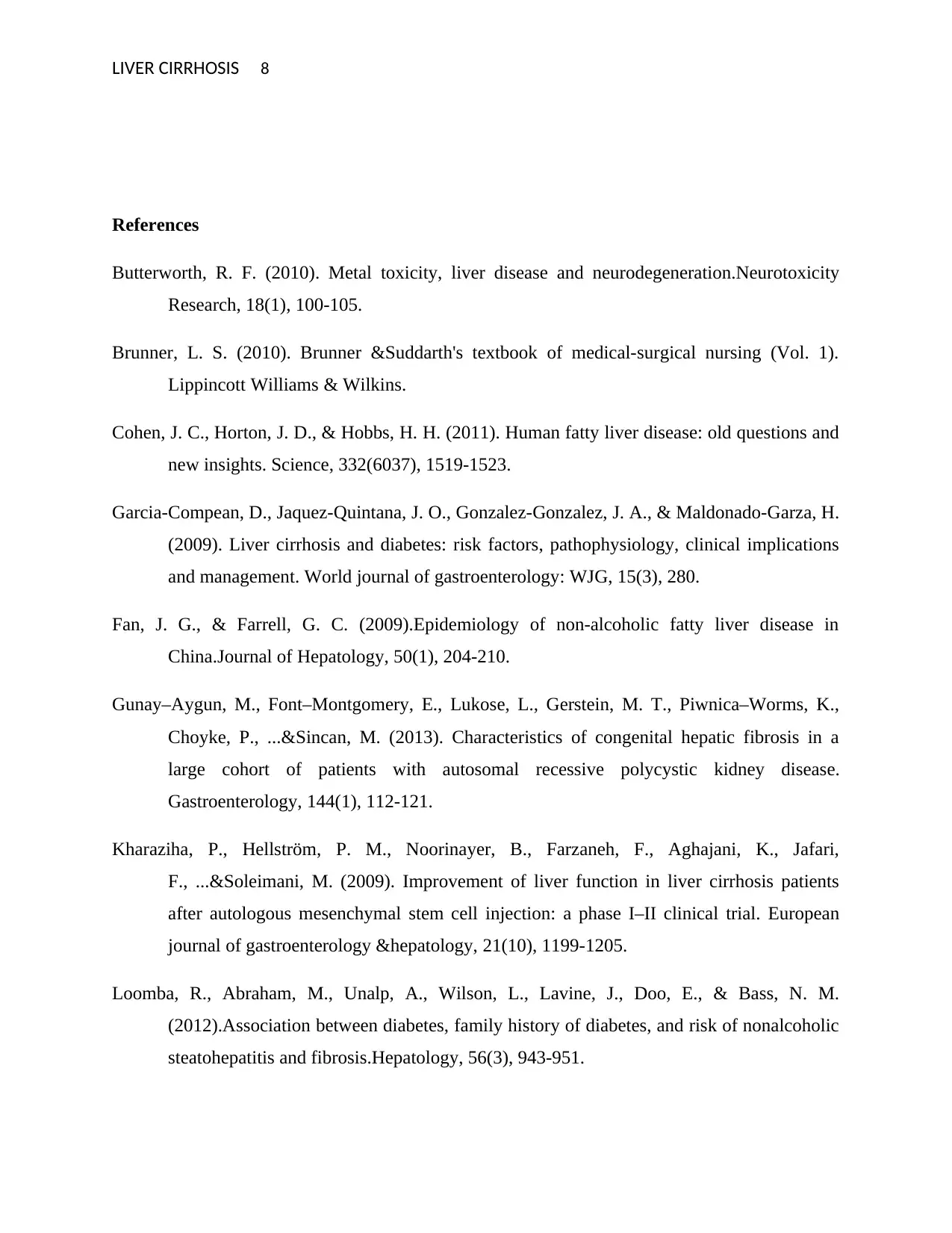
LIVER CIRRHOSIS 8
References
Butterworth, R. F. (2010). Metal toxicity, liver disease and neurodegeneration.Neurotoxicity
Research, 18(1), 100-105.
Brunner, L. S. (2010). Brunner &Suddarth's textbook of medical-surgical nursing (Vol. 1).
Lippincott Williams & Wilkins.
Cohen, J. C., Horton, J. D., & Hobbs, H. H. (2011). Human fatty liver disease: old questions and
new insights. Science, 332(6037), 1519-1523.
Garcia-Compean, D., Jaquez-Quintana, J. O., Gonzalez-Gonzalez, J. A., & Maldonado-Garza, H.
(2009). Liver cirrhosis and diabetes: risk factors, pathophysiology, clinical implications
and management. World journal of gastroenterology: WJG, 15(3), 280.
Fan, J. G., & Farrell, G. C. (2009).Epidemiology of non-alcoholic fatty liver disease in
China.Journal of Hepatology, 50(1), 204-210.
Gunay–Aygun, M., Font–Montgomery, E., Lukose, L., Gerstein, M. T., Piwnica–Worms, K.,
Choyke, P., ...&Sincan, M. (2013). Characteristics of congenital hepatic fibrosis in a
large cohort of patients with autosomal recessive polycystic kidney disease.
Gastroenterology, 144(1), 112-121.
Kharaziha, P., Hellström, P. M., Noorinayer, B., Farzaneh, F., Aghajani, K., Jafari,
F., ...&Soleimani, M. (2009). Improvement of liver function in liver cirrhosis patients
after autologous mesenchymal stem cell injection: a phase I–II clinical trial. European
journal of gastroenterology &hepatology, 21(10), 1199-1205.
Loomba, R., Abraham, M., Unalp, A., Wilson, L., Lavine, J., Doo, E., & Bass, N. M.
(2012).Association between diabetes, family history of diabetes, and risk of nonalcoholic
steatohepatitis and fibrosis.Hepatology, 56(3), 943-951.
References
Butterworth, R. F. (2010). Metal toxicity, liver disease and neurodegeneration.Neurotoxicity
Research, 18(1), 100-105.
Brunner, L. S. (2010). Brunner &Suddarth's textbook of medical-surgical nursing (Vol. 1).
Lippincott Williams & Wilkins.
Cohen, J. C., Horton, J. D., & Hobbs, H. H. (2011). Human fatty liver disease: old questions and
new insights. Science, 332(6037), 1519-1523.
Garcia-Compean, D., Jaquez-Quintana, J. O., Gonzalez-Gonzalez, J. A., & Maldonado-Garza, H.
(2009). Liver cirrhosis and diabetes: risk factors, pathophysiology, clinical implications
and management. World journal of gastroenterology: WJG, 15(3), 280.
Fan, J. G., & Farrell, G. C. (2009).Epidemiology of non-alcoholic fatty liver disease in
China.Journal of Hepatology, 50(1), 204-210.
Gunay–Aygun, M., Font–Montgomery, E., Lukose, L., Gerstein, M. T., Piwnica–Worms, K.,
Choyke, P., ...&Sincan, M. (2013). Characteristics of congenital hepatic fibrosis in a
large cohort of patients with autosomal recessive polycystic kidney disease.
Gastroenterology, 144(1), 112-121.
Kharaziha, P., Hellström, P. M., Noorinayer, B., Farzaneh, F., Aghajani, K., Jafari,
F., ...&Soleimani, M. (2009). Improvement of liver function in liver cirrhosis patients
after autologous mesenchymal stem cell injection: a phase I–II clinical trial. European
journal of gastroenterology &hepatology, 21(10), 1199-1205.
Loomba, R., Abraham, M., Unalp, A., Wilson, L., Lavine, J., Doo, E., & Bass, N. M.
(2012).Association between diabetes, family history of diabetes, and risk of nonalcoholic
steatohepatitis and fibrosis.Hepatology, 56(3), 943-951.

LIVER CIRRHOSIS 9
McPhee, S. J., Papadakis, M. A., &Rabow, M. W. (Eds.).(2010). Current medical diagnosis &
treatment 2010. New York:: McGraw-Hill Medical.
Melo-Cristino, J., Resina, C., Manuel, V., Lito, L., & Ramirez, M. (2013).The first case of
infection with vancomycin-resistant Staphylococcus aureus in Europe.The Lancet,
382(9888), 205.
Miller, M., Stone, N. J., Ballantyne, C., Bittner, V., Criqui, M. H., Ginsberg, H. N., ...&Lennie,
T. A. (2011). Triglycerides and cardiovascular disease: a scientific statement from the
American Heart Association. Circulation, 123(20), 2292-2333.
McPhee, S. J., Papadakis, M. A., &Rabow, M. W. (Eds.).(2010). Current medical diagnosis &
treatment 2010. New York:: McGraw-Hill Medical.
MohdHanafiah, K., Groeger, J., Flaxman, A. D., &Wiersma, S. T. (2013). Global epidemiology
of hepatitis C virus infection: New estimates of age‐specific antibody to HCV
seroprevalence. Hepatology, 57(4), 1333-1342.
Rehm, J., Taylor, B., Mohapatra, S., Irving, H., Baliunas, D., Patra, J., &Roerecke, M. (2010).
Alcohol as a risk factor for liver cirrhosis: A systematic review and meta‐analysis. Drug
and alcohol review, 29(4), 437-445.
Rotman, Y., Koh, C., Zmuda, J. M., Kleiner, D. E., & Liang, T. J. (2010).The association of
genetic variability in patatin‐like phospholipase domain‐containing protein 3 (PNPLA3)
with histological severity of nonalcoholic fatty liver disease.Hepatology, 52(3), 894-903.
Schuppan, D., &Afdhal, N. H. (2008).Liver cirrhosis. The Lancet, 371(9615), 838-851.
Valenti, L., Al‐Serri, A., Daly, A. K., Galmozzi, E., Rametta, R., Dongiovanni,
P., ...&Bugianesi, E. (2010). Homozygosity for the patatin‐like
phospholipase‐3/adiponutrin I148M polymorphism influences liver fibrosis in patients
with nonalcoholic fatty liver disease. Hepatology, 51(4), 1209-1217.
McPhee, S. J., Papadakis, M. A., &Rabow, M. W. (Eds.).(2010). Current medical diagnosis &
treatment 2010. New York:: McGraw-Hill Medical.
Melo-Cristino, J., Resina, C., Manuel, V., Lito, L., & Ramirez, M. (2013).The first case of
infection with vancomycin-resistant Staphylococcus aureus in Europe.The Lancet,
382(9888), 205.
Miller, M., Stone, N. J., Ballantyne, C., Bittner, V., Criqui, M. H., Ginsberg, H. N., ...&Lennie,
T. A. (2011). Triglycerides and cardiovascular disease: a scientific statement from the
American Heart Association. Circulation, 123(20), 2292-2333.
McPhee, S. J., Papadakis, M. A., &Rabow, M. W. (Eds.).(2010). Current medical diagnosis &
treatment 2010. New York:: McGraw-Hill Medical.
MohdHanafiah, K., Groeger, J., Flaxman, A. D., &Wiersma, S. T. (2013). Global epidemiology
of hepatitis C virus infection: New estimates of age‐specific antibody to HCV
seroprevalence. Hepatology, 57(4), 1333-1342.
Rehm, J., Taylor, B., Mohapatra, S., Irving, H., Baliunas, D., Patra, J., &Roerecke, M. (2010).
Alcohol as a risk factor for liver cirrhosis: A systematic review and meta‐analysis. Drug
and alcohol review, 29(4), 437-445.
Rotman, Y., Koh, C., Zmuda, J. M., Kleiner, D. E., & Liang, T. J. (2010).The association of
genetic variability in patatin‐like phospholipase domain‐containing protein 3 (PNPLA3)
with histological severity of nonalcoholic fatty liver disease.Hepatology, 52(3), 894-903.
Schuppan, D., &Afdhal, N. H. (2008).Liver cirrhosis. The Lancet, 371(9615), 838-851.
Valenti, L., Al‐Serri, A., Daly, A. K., Galmozzi, E., Rametta, R., Dongiovanni,
P., ...&Bugianesi, E. (2010). Homozygosity for the patatin‐like
phospholipase‐3/adiponutrin I148M polymorphism influences liver fibrosis in patients
with nonalcoholic fatty liver disease. Hepatology, 51(4), 1209-1217.
⊘ This is a preview!⊘
Do you want full access?
Subscribe today to unlock all pages.

Trusted by 1+ million students worldwide
1 out of 9
Related Documents
Your All-in-One AI-Powered Toolkit for Academic Success.
+13062052269
info@desklib.com
Available 24*7 on WhatsApp / Email
![[object Object]](/_next/static/media/star-bottom.7253800d.svg)
Unlock your academic potential
Copyright © 2020–2025 A2Z Services. All Rights Reserved. Developed and managed by ZUCOL.





